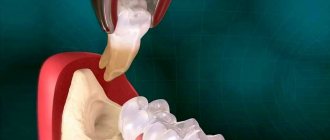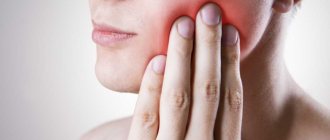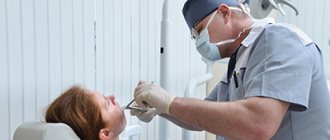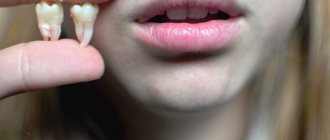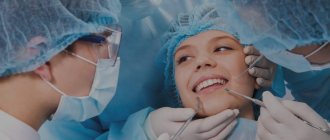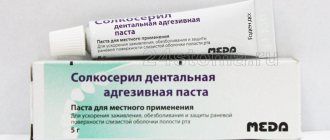Situations requiring tooth extraction are familiar to most of us. Even if we are not talking about removal due to an advanced disease or inflammatory process, at least in childhood, each of us went through the period of changing milk teeth to molars. Sometimes everything happened by itself, and the tooth could be reached literally with your hand in one movement. And sometimes the task required a visit to the dentist's office. Remember what emotions we experienced at this age, what horror every trip to the doctor inspired. Inevitable associations with unbearable pain (which, most often, did not exist at all) and fear of the dental chair. However, with age, everything changes and adults, for the most part, understand that there is no need to be afraid of the dentist, but it is necessary to take care of your teeth, because it is thanks to regular visits to the dentist and careful oral care that it is possible to avoid dental problems and the very pain that comes with it. everyone is afraid.
At the same time, even in cases where a person shows high responsibility towards his health, it may be necessary to remove a tooth. First of all, this concerns wisdom teeth. In addition to the fact that the procedure itself is often painful, due to the peculiarities of their location, as well as the different age of complete eruption, the removal of wisdom teeth can be accompanied by unpleasant complications. However, by entrusting the procedure to a qualified specialist, you can be sure of a positive outcome. However, in order to avoid problems during the healing process of the gums, you should strictly follow all the doctor’s recommendations for hygienic treatment of the oral cavity.
Painless tooth extraction in Moscow - Selin aesthetic dentistry clinic
Content:
- A tooth has been removed: can you or can’t smoke?
- Why smoking after removal is undesirable
- Is it possible to smoke after tooth extraction if there are stitches on the gums?
- Smoking and anesthesia are an undesirable combination
- Useful information about the effect of nicotine on the mucous membranes of the oral cavity
- How to speed up the healing of a hole
A person who has just had a tooth removed is usually nervous. This is understandable - he has suffered stress and wants to relax. Smokers often use cigarettes to calm down, but the question arises: when can you smoke after dental surgery? We suggest you look into it.
How is the affected tooth removed?
The procedure itself should only be performed by an experienced surgeon and only when other treatment methods can no longer help. There are a number of reasons that can trigger the removal of an affected tooth:
- if the crown of the tooth is completely destroyed;
- when the patient is indicated for prosthetics;
- if complications arise during the eruption of a wisdom tooth;
- if filling requires perforation of the root canal.
A tooth can be removed for many reasons
Important ! There are cases when there is every reason to remove a tooth, but the patient has contraindications to this. In such cases, most often the intervention is carried out within the walls of a hospital with subsequent monitoring of the patient’s condition.
There are a number of main contraindications to surgical tooth extraction. These include:
- previous heart attacks;
- high blood pressure;
- arrhythmia;
- blood diseases;
- mental problems or neurological diseases.
There is a certain scheme for tooth extraction
If no contraindications have been identified in a patient who needs surgical removal of the affected tooth, then he is referred to the procedure itself, which should be carried out according to the following scheme.
| Stage | Description |
| Visit doctor | Before performing the procedure, the doctor must find out whether the patient has allergic reactions to any anesthetics, cardiovascular pathologies, or whether the patient suffers from hypertension. |
| Anesthesia | After all the necessary information has been obtained, the patient is sent for anesthesia. A fairly large number of different means are currently used to remove teeth. Their duration of action is from forty minutes to three hours. |
| Preparation | Next comes preparation for the intervention itself: in order not to injure the gum during manipulation, it first peels off from the tooth bone by at least five millimeters. This procedure is carried out using a special tool. The surgeon places special forceps on the tooth, and then begins to swing the tooth itself with them in order to destroy the ligaments attached to the jaw bone. |
| Removal | The affected tooth itself is pulled out, that is, extraction. After the affected tooth has been removed, the resulting hole must be thoroughly examined. This is necessary so as not to leave tooth fragments or a cyst in the wound cavity. If the extraction of the affected tooth took place in the presence of flux, then after its removal the gums are cut in the right place and the pus is released. After this manipulation, a drainage is inserted into the wound cavity. |
| Treatment | After the procedure is completed, you need to treat the wound itself. If pus is found at the site of the lesion, then in this case the hole must be washed with an antiseptic solution, and then an anti-inflammatory agent should be placed in the wound. If the hole itself is too large after extracting the tooth, then a suture is necessary. |
| Consultation | After the procedure has been completely completed, before discharge, the doctor must instruct the patient in detail on how to care for the hole during the healing period, and also prescribe any medications if necessary. |
After the tooth is removed and before the patient goes home, the doctor inserts a special medicine into the tooth socket. It is necessary to protect the wound from various influences, as well as for faster and more proper healing. Some patients complain that the turunda with the medicine interferes greatly, but this will have to be endured.
Important ! If you remove the turunda ahead of time, serious complications may develop, which will have to be dealt with not only by the dentist, but also by other doctors.
A special medicine is placed in the hole
The doctor prescribes exactly the medicine that is safe for every person. True, it does not have the most pleasant taste, but a person will have to ignore this factor if he wants the wound to heal as quickly as possible.
There are exceptional cases when it is simply impossible to remove the affected tooth according to the scheme above. The reason for this may be the following factors:
- How long does it take for drugs to leave the body?
- if the tooth root is crooked;
- if the bone tissue of the tooth is too fragile;
- if the crown of the affected tooth is already completely destroyed;
- if the figure eight is in a position of incomplete eruption or in a horizontal position.
If a patient who needs tooth extraction has any of these characteristics, then the intervention is performed in a different way. First, the gum is cut and peeled away from the bone. After this, the specialist drills out the desired area using a drill, which creates access to the root of the required tooth.
Important ! In some cases, the partitions between the roots of the tooth are sawed, after which each root is removed one by one.
In some cases, the tooth is removed differently
After such procedures, healing is more difficult and longer. Such an intervention may cause the patient to develop stomatitis. In many cases of such intervention, a secondary infection is attached to the affected area.
However, no matter which tooth is removed, medicine must be placed in the hole. This procedure is required.
A tooth has been removed: can you or can’t smoke?
Dental surgeons prohibit smoking during the first two to three hours after extraction. This short period is relevant if:
- the operation was not very complicated;
- the bleeding has stopped completely;
- after removing the gauze swab, blood did not begin to flow again;
- a dense blood clot has managed to form, isolating the wound in the gum.
In severe cases, smoking after tooth extraction will have to be postponed for several days - the exact time period will be determined by the doctor. This is due to the fact that nicotine contained in cigarette smoke irritates the edges of the inflamed hole and causes spasm of blood vessels. Because of this, regeneration processes slow down and dangerous complications can develop.
Antiseptic rinses/baths –
Remember that you should not rinse your mouth vigorously during the first few days after removal, because... you can easily rinse the blood clot out of the socket. Food will constantly accumulate in a hole without a clot and rot there, causing inflammation and pain. It is better to replace rinses with baths (pour an antiseptic solution into your mouth, hold it and spit it out, or lightly “squelch” it).
When are antiseptic baths necessary?
- if the tooth was removed due to inflammation,
- an incision was made on the gum to expose the gumboil,
- if you have teeth with untreated caries or dental plaque, infection in which can lead to suppuration of a blood clot.
Antiseptic baths are best done with an aqueous solution of Chlorhexidine 0.05-0.12%. This drug has a pronounced antiseptic effect and is slightly bitter in taste. Baths should be done 3 times a day (keep the solution in your mouth for about 1 minute each time).
Why smoking after removal is undesirable
If you start smoking after leaving the dentist's office, you may experience dry socket problems. This means that the blood clot formed to protect the wound from the penetration of pathogens will collapse. Then the tissues will be left without a natural barrier. When smoking further cigarettes and eating food, irritating substances will enter the hole. In this case, there is no hope for quick healing.
The inflammatory process that has developed due to dry socket manifests itself:
- pain at the location of the torn unit;
- increased body temperature;
- accumulation of purulent masses in the wound;
- foul breath.
There is no point in hoping that the situation will normalize on its own. If you have a dry socket, you should visit your dental surgeon again as soon as possible.
Prevention
There are a number of actions that the patient must take immediately after this procedure and which will allow him to prevent possible complications.
- How to deal with unpleasant odors in the home of a seriously ill person
- After the extraction, the patient needs to tightly compress the dentition. This is necessary in order to press firmly on the tampon placed in the wound.
- The medicine should not be removed by yourself.
- The hole should not be touched with your tongue or fingers. This is necessary so as not to accidentally damage the blood clot that has formed in the wound.
- If the patient experiences unbearable pain, it can be relieved with the help of analgesics that were recommended by a specialist. The dosage should also be prescribed by the doctor, since each patient reacts individually to the tooth extraction procedure.
- During the period until the wound is completely healed, the patient should stop smoking. This process greatly interferes with the normal healing of the hole.
- If the patient detects symptoms of complications, then, without delay, he should consult a dentist.
You should contact your dentist if complications occur.
The patient needs to be aware of symptoms that may indicate the occurrence of suppuration or any other complications. Having noticed any of the signs, the patient should immediately contact a specialist for advice and subsequent treatment. We must not forget that only proper maintenance of oral hygiene and compliance with all the necessary rules will help the wound heal much faster. You will find out the proportions of soda solution for rinsing teeth in the article.
Smoking and anesthesia are an undesirable combination
Doctors insist that patients do not smoke for the next two to three hours after extraction for good reason. Anesthetics used during dental surgery make the tissue completely insensitive and reduce the activity of some muscles and can change the breathing rate. It is very important to wait until their effect ends.
Nicotine and carbon monoxide entering the oral cavity during smoking a cigarette cause spasm of blood vessels and reduce oxygen saturation in the blood. The combination of all these factors leads to a situation where the tissues of the mouth do not receive enough oxygen, which is important for their restoration.
Useful information about the effect of nicotine on the mucous membranes of the oral cavity
The mucous membranes of the human oral cavity are lined with very delicate and easily vulnerable epithelium. With the systematic use of tobacco products, nicotine and toxic tars damage tissue. The situation is aggravated by the negative impact of elevated temperature when inhaling cigarette smoke.
This is why smokers are often diagnosed with gingivitis and periodontitis. The components present in the smoke change the ligamentous apparatus of the tooth. The gums become inflamed. In the absence of adequate treatment and the persistence of a bad habit, the inflammatory process progresses. Then the unit becomes mobile.
Compounds present in cigarette smoke spasm peripheral blood vessels, disrupt tissue trophism and increase inflammation. Most often, the disease occurs without acute pain and bleeding, so the smoker is in no hurry to see a dentist. But, if you go to the doctor late, you can lose your tooth ahead of time.
How to speed up the healing of a hole
Dentists always give the patient individual recommendations that must be followed. But there are general rules that apply to all patients:
- Do not smoke for at least two to three hours.
- Promptly remove the tampon soaked in antiseptic from the postoperative wound. If you forget to do this, the fabric will become a suitable breeding ground for bacteria.
- Do not touch the blood clot covering the wound. It cannot be picked or felt. The speed of recovery directly depends on the state of the clot.
- When rinsing, do not make intense movements that will help wash out the clot. You just need to put the medicinal solution in your mouth and carefully hold it on the side of the extracted tooth.
- Do not apply medications to the affected area that have not been prescribed by a doctor. Such amateur activities can lead to dangerous complications.
- In the first three days after extraction, do not take a hot bath or steam in a bathhouse or sauna.
- Do not eat until the anesthesia wears off. Otherwise, you may bite the tissue of your cheek or lip.
- Take only those medications prescribed by your dentist. Sometimes doctors decide to prescribe antibiotics - they must be taken strictly according to the specified regimen.
How the regeneration process will proceed depends not only on the actions of the dental surgeon, but also on the behavior of the patient. Remember this!
Auxiliary medications for tooth extraction
If, after the tooth is removed, any complications begin at the intervention site, then modern pharmaceuticals can cope with them. With the help of various medications, the patient can not only eliminate the resulting secondary complications, but also strengthen his immunity as a whole. Quite often, specialists, to ensure against possible complications, in particular, various inflammations and suppurations, prescribe antibacterial drugs in the postoperative period. At the same time, the patient also needs to strengthen the immune system, which will help the wound heal faster. To do this, doctors prescribe vitamin complexes to the patient. Thus, in addition to the medicine placed in the hole and affecting its healing, the patient is recommended to take other drugs to speed up the process.
Your doctor may recommend taking medications to strengthen your immune system.
If during the procedure the patient was identified with any peculiarities or complications and tooth extraction was not without additional trauma, then a number of medications are prescribed in the postoperative period, since in this case there are additional risks of complications. The main thing is that the patient treats the postoperative period responsibly and does not neglect the doctor’s advice and the medications prescribed to him.
Important ! According to statistics, every third patient who has had a tooth removed needs to take antibiotics.
